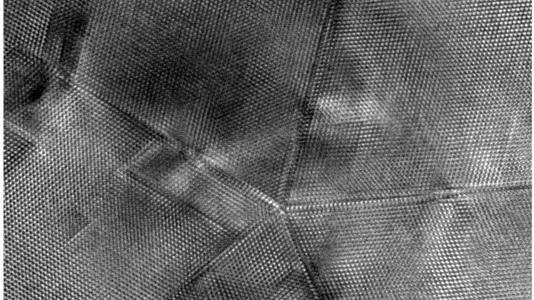
After spending close to a decade examining the structure of nanowires made of pure silver, scientists at the U.S. Department of Energy’s (DOE) Argonne National Laboratory have discovered a set of unusual behaviors in nanocrystals with a strained, five-fold symmetry formed by “twinning” in the crystal structure. The twinned crystals’ unusual pentagonal symmetry and complicated structures distinguish them from the cubic crystalline lattices typical of many silver nanoparticles.
The “twinned” structures occur when adjacent domains within the nanoparticle arrange themselves by sharing the same planes, said Argonne nanoscientist Yugang Sun. Since the five-fold twinned structures do not perfectly fill the volume that the atoms would normally occupy in silver, there is a lot of strain in the atomic structure or lattice. Typically, nanoparticles made from precious metals have formed highly symmetric lattices in a configuration called “face-centered cubic”; but the strains in five-fold twinned nanowires distort the lattices into a body-centered tetragonal symmetry.
The difference between the atom arrangements in nanoparticles could determine both the strength of the material as well as its efficiency as a catalyst, Sun said. “This is a fundamental study that looks in depth into the nature of metals at the most basic level,” he said. “However, it’s essential that scientists understand such properties in order to exploit any advantages that these very small structures might provide us down the road.”
Sun and his colleagues also discovered that the lattice stresses are absorbed unequally by different regions of the nanowires. The center, he said, exhibits signs of high strain, while the outer layer is not strained as much. This behavior suggests each nanowire is actually composed of two distinct regions – something that is very important to determine the stability of the highly strained nanowires.
The unusual structure of the silver nanowires also allows materials scientists to establish how strain distributes itself along one extended dimension. “This can answer a lot of questions that remain in materials science, particularly for this kind of common structure,” Sun said.
The work was performed at Argonne’s Center for Nanoscale Materials, Electron Microscopy Center and Advanced Photon Source.
The paper was published online in the July 24 issue of Nature Communications.
The Center for Nanoscale Materials is one of the five DOE Nanoscale Science Research Centers, premier national user facilities for interdisciplinary research at the nanoscale supported by the U.S. Department of Energy, Office of Science. Together the NSRCs comprise a suite of complementary facilities that provide researchers with state-of-the-art capabilities to fabricate, process, characterize and model nanoscale materials, and constitute the largest infrastructure investment of the National Nanotechnology Initiative. The NSRCs are located at DOE’s Argonne, Brookhaven, Lawrence Berkeley, Oak Ridge, Sandia and Los Alamos National Laboratories. For more information about the DOE NSRCs, please click here.
Argonne National Laboratory seeks solutions to pressing national problems in science and technology. The nation’s first national laboratory, Argonne conducts leading-edge basic and applied scientific research in virtually every scientific discipline. Argonne researchers work closely with researchers from hundreds of companies, universities, and federal, state and municipal agencies to help them solve their specific problems, advance America’s scientific leadership and prepare the nation for a better future. With employees from more than 60 nations, Argonne is managed by UChicago Argonne, LLC for the U.S. Department of Energy’s Office of Science.
DOE’s Office of Science is the single largest supporter of basic research in the physical sciences in the United States, and is working to address some of the most pressing challenges of our time. For more information, please visit science.energy.gov.